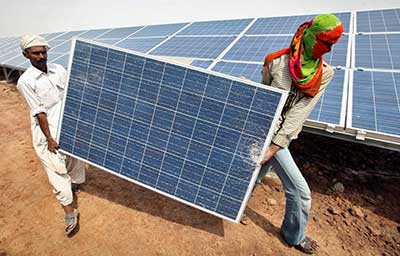Relevance: GS-3: Science and Technology- developments and their applications and effects in everyday life.
Key Phrases: Environment Performance Index 2022, World Economic Forum, Ecosystem vitality, GHG emission per capita, Common but Differentiated Responsibilities and Respective Capabilities, Waste generation per capita, Sustainable consumption.
Why in News?
- Augmenting domestic research, commercialising evolving technologies, unlocking export markets and making available the required capital are vital for solar module manufacturing in India.
Context:
- The recent power crisis once again highlighted India’s reliance on
thermal power for generating electricity. The crisis stemmed from the
convergence of multiple factors such as a
- Shortage of coal stocks
- Post-Covid supply chain issues
- Record-high prices of coal in the international market.
- A more rapid shift to renewables would be essential to reduce dependence on coal for meeting the increasing power demand.
- However, the concentration of clean energy manufacturing in China poses supply chain risks to India’s energy transition and could threaten its energy security in the coming decades. For instance, in 2021, solar module prices increased by up to 40 per cent due to raw material shortages and supply chain disruptions in China.
State of India’s Solar Capacity
- India’s capacity additions rank the country fifth in solar power deployment, contributing nearly 6.5% to the global cumulative capacity of 709.68 GW.
- Of the 50 GW installed solar capacity
- 42 GW comes from ground-mounted solar photovoltaic (PV) systems,
- 6.48 GW comes from rooftop solar (RTS).
- 1.48 GW from off-grid solar PV.
- India had 3 GW capacity for solar cell production and 15 GW for solar panel production capacity.
Challenges Affecting Solar Module Manufacturing in India:
- Factors including lack of financing support, inconsistent government policy, lack of scale and competition from low-priced Chinese imports led to the undercutting of India’s domestic module manufacturing growth.
- Most of the central government initiatives could not catalyse a nation-wide movement towards the indigenisation of the PV value chain in the desired manner.
- Apart from the policy and regulations concerning the industry, there are considerable techno-economic risks involved in the setting up and operation of module manufacturing facilities in India.
- The demand for indigenously made solar cells is generally low because module suppliers demand cells of higher grade (in terms of wattage, efficiency, etc).
- In addition to this, due to the narrow cell production scale for most cell manufacturers, domestic cells are more expensive.
- Manufacture of solar panels (also called modules) start with polysilicon, which is made from silicon.
- Currently only modules and cells are made in India, with imported material. When it comes to figures, currently, almost 90 percent of panels and modules in Indian projects are imported, mostly from China, Malaysia and Taiwan, as they are significantly cheaper than the ones made locally.
Strategic measures needed to boost Solar Module Manufacturing:
- India must implement a national strategy to augment domestic research and development of solar technologies with the support of local industry and government providing necessary policy support.
- Prioritising key innovations with targets and timelines
- Need to commercialise the R&D spending. A failure to convert R&D spending into practical market products is a key reason behind the decline of solar manufacturing in the US.
- MNRE should also provide seed capital to early-stage solar manufacturing ventures by creating a government-anchored investment fund.
- Simultaneously, MNRE could create demand-pull for new technologies by mandating government tendering agencies to use modules developed under the technology roadmap for at least 5 per cent of awarded solar capacity.
- Need to unlock export markets through Exim Bank financing and prioritising low-carbon solar manufacturing as the domestic market alone would lead to demand ceiling.India must leverage the International Solar Alliance (ISA) network to provide financing for solar projects in member countries.
- Need to increase the amount of debt capital available to solar manufacturers in the near term. As per recent CEEW-CEF study the manufacturers would require $7.2 billion (₹53,773 crore) in capital expenditure alone over the next 3-4 years. As a dedicated financier for the renewable energy sector, IREDA must raise the share of loans to manufacturers from the existing 4 per cent to at least 20 per cent by 2026.
- State governments should set up manufacturing hubs for upcoming factories and should also add solar manufacturing to the list of thrust sectors in their industrial policies. Support in the form of infrastructure,skilled labour and land parcels can be provided.
Government Initiatives:
- Additional domestic solar equipment manufacturing capacity of 25 gigawatts (GW) each of solar cells and modules, and 10GW of wafers by April 2023.
- India currently has a manufacturing capacity of 3GW for solar cells and 15GW for modules. The plan to augment local manufacturing follows an additional allocation of Rs19,500crore for the production-linked incentive (PLI) scheme for high-efficiency solar modules in the FY23 Union budget.
- This is in addition to the Rs4,500crore already allocated to the scheme for manufacturing solar photovoltaic modules. The manufacturing push comes ahead of India’s plan to impose a basic customs duty of 40% on modules and 25% on solar cell imports from 1 April 2022.
- A large manufacturing zone each in a coastal state, a mountain state and a landlocked state are being set up to produce power and renewable energy equipment.
- Viability Gap funding scheme is implemented by SECI. In the past few years, SECI has made multiple project allocations under the VGF mechanism.
Conclusion:
- Rapid solar deployment is the backbone of India’s climate ambitions and energy security. With the above-mentioned measures, India could develop a robust and technology-led domestic solar manufacturing ecosystem on the path to net-zero by 2070. A thriving local industry would also generate new jobs along with delivering on growth and sustainability.
Source: The Hindu BL
Mains Question:
Q. Discuss the reasons for low solar module manufacturing in India. Suggest measures needed to boost Solar Module Manufacturing in India.








